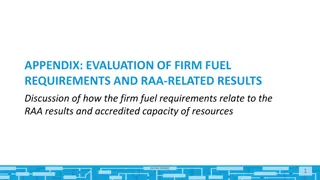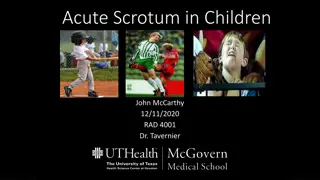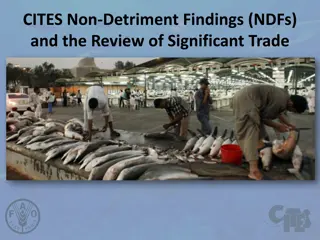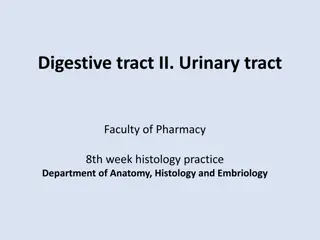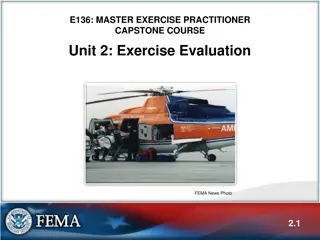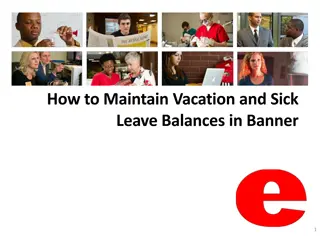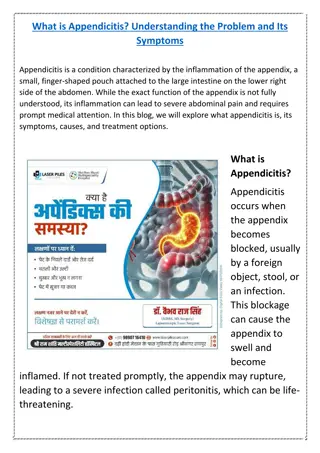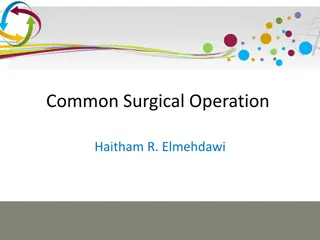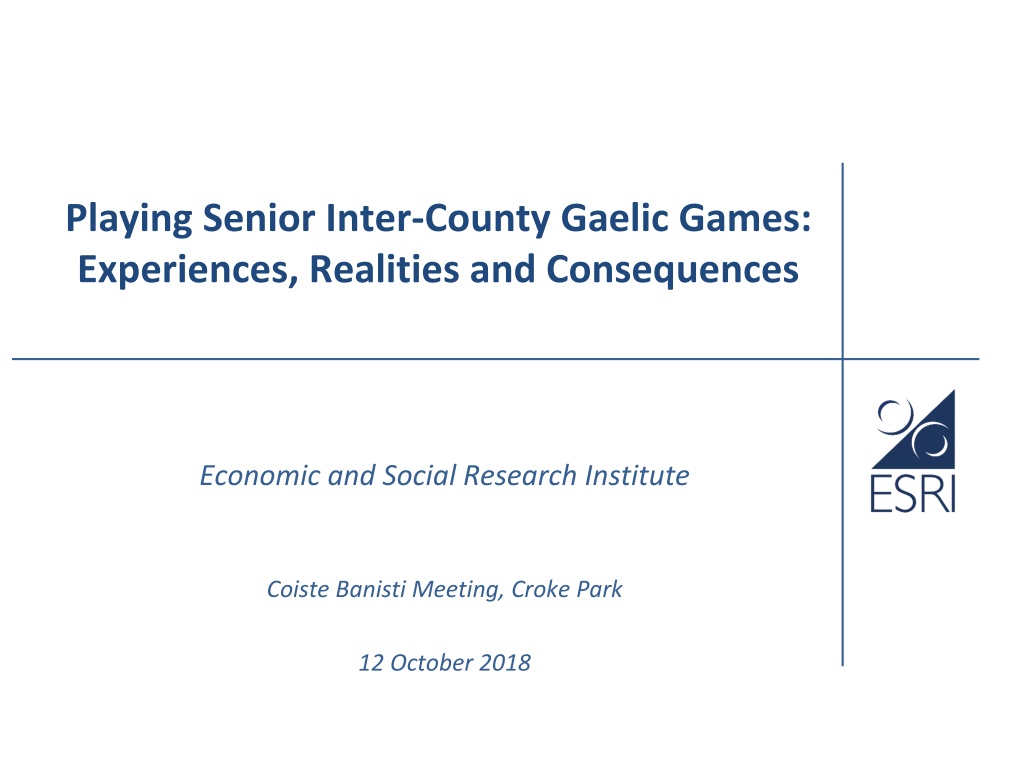
Senior Inter-County Gaelic Games Research: Commitment and Welfare
Delve into the impact of playing senior inter-county Gaelic games on players' lives and welfare, examining commitments required, key findings, and policy implications. Research objectives include player welfare, personal and professional impact, and club involvement assessment. The study explores the demands placed on players, effects on personal and professional lives, and the establishment of an oversight body for player welfare.
Download Presentation

Please find below an Image/Link to download the presentation.
The content on the website is provided AS IS for your information and personal use only. It may not be sold, licensed, or shared on other websites without obtaining consent from the author. Download presentation by click this link. If you encounter any issues during the download, it is possible that the publisher has removed the file from their server.
E N D
Presentation Transcript
Playing Senior Inter-County Gaelic Games: Experiences, Realities and Consequences Economic and Social Research Institute Coiste Banisti Meeting, Croke Park 12 October 2018
Outline Background Research objectives Research methodology Some of the key findings Player welfare policy implications Concluding observations Further work
Background Developments in the games Increased commitment required from players Concern demands having negative effects on players lives GAA/GPA 2017 2019 agreement working party established ESRI commissioned to undertake an independent examination
Research Objectives 1. Commitments required to player senior inter-county 2. Impact on players personal and professional lives 3. Impact on club involvement Profile against which future generations can be benchmarked
Research Methodology Player workshops and survey of 2016 players Also: Oversight Body established Player welfare literature review Manager, county-board secretary, GDO workshops Situation for all senior inter-county players Also: Code, age, playing level and residency (county not feasible)
Commitment Required to Playing Senior Inter-County
Time Key commitment knock-on implications 1. Field-based and sports conditioning sessions 2. Individually instigated training sessions 3. Other Gaelic teams (Club) Number of Gaelic teams involved with during 2016 Time off from Gaelic games during 2016
Average Number of Hours Per Day (2016 Championship: late May/June) Trained Gear/Food Total Proportion (%) Training Travel Preparation (Hours) of Day (%) Field-Based: - All Players 100% 2.9 2.1 1.1 6.1 25.2% - Resident Within County 100% 2.9 1.8 1.1 5.8 24.3% - Resident Outside County 100% 2.6 3.0 1.0 6.7 27.9% Sports Conditioning (M): - All Players 91.6% 1.6 1.8 1.1 4.6 19.0% - Resident Within County 91.2% 1.6 1.7 1.2 4.4 18.4% - Resident Outside County 92.7% 1.6 2.4 1.0 5.0 20.9% Sports Conditioning (NM): - All Players 95.3% 2.0 1.8 1.1 5.0 20.8% - Resident Within County 94.7% 2.0 1.7 1.1 4.9 20.2% - Resident Outside County 97.2% 1.9 2.4 1.1 5.4 22.5%
Average Number Per Week Field-based and Sports Conditioning Training Sessions: (Monday Sunday) Match Week 3.9 Non-Match Week 4.9 Average Number Per Week Individually Instigated Training Sessions: Trained (%) (Monday Sunday) Match Week 72.0% 1.5 Non-Match Week 83.0% 1.9
Average Number of Hours Per Week (2016 Championship: late May/June) Match Applicable Non-Match Applicable Week to (%): Week to (%): Session Type: Field-Based Only 14.5 3.2% 18.2 1.2% Field-Based and Sports Conditioning Only 21.4 19.6% 27.6 12.1% Field-Based Only and Individually-Instigated 16.6 5.4% 21.4 3.4% Field-Based and Sports Conditioning and Individually-Instigated 23.5 71.9% 30.8 83.2%
Other Gaelic Team Involvement Average Number Average Number of Trained (%) Sessions Per Week Hours Per Week Match Week 32.7 2.1 4.0 Non-Match Week 61.0 2.1 4.0
Multiple Team Involvement (%) All Aged Aged Aged Aged No. of Teams Players 18-21 22-25 26-30 30 Plus 2 40.0 10.1 36.0 60.0 66.0 3 33.1 22.3 45.0 30.0 25.0 4 13.8 25.8 14.0 7.0 [*] 5 7.7 24.9 [<3.0] [*] [*] 6+ 5.4 16.9 [<4.0] [*] [*] Total 100 100 100 100 100
Time Off 80.0 60.3 60.0 59.7 60.0 Percent 40.3 40.0 39.7 40.0 20.0 0.0 All Players Football Hurling Yes No 7.0 6.0 5.5 5.1 4.8 5.0 Weeks 4.0 3.0 2.0 1.0 0.0 All Players Football Hurling
Player Welfare Implications I: Sports conditioning: Adding substantially to overall training load Policies aimed at prevent injury and/or burnout Travel: Volume increasing injury risk, suboptimal performance Management teams cognisant of this when formulating training regimes Multiple team involvement: Players aged 18-21 Changes to HE competition structures not feasible = consideration given to collaboration by college and county management teams No official off-season: Increasing risk of player burnout Consideration given again to introduction of an official off-season
Knock-on Effects of Inter-County Time Commitments
24-Hour Pitch-Based Training Day: 2016 Championship 9.0 7.9 7.6 8.0 7.0 6.1 6.0 5.0 Hours 4.0 2.9 3.0 2.4 2.1 2.0 1.1 1.0 0.0 Professional Other Sleep IC Training IC Travel IC Gear/Food IC Total
Other Ring-fence time allocation to inter-county activities by compromising on other aspects of their lives Personal relationships and general downtime: 1. 2016 players spent mere 2.4 hours 2. Majority (61%) spent 2 hours or less 3. Sacrifice greater among players aged over 30, and those resident outside of home county
Time Allocated to Personal Relationships, General Downtime 50.0 45.9 45.0 40.0 36.0 34.1 32.3 33.2 35.0 31.5 28.9 29.0 30.0 25.7 Percent 25.0 22.2 21.0 21.6 21.3 21.3 20.0 17.4 17.1 17.0 17.0 15.7 15.0 11.7 10.0 5.0 0.0 All Players Aged 18-21 Aged 22-25 Aged 26-30 Aged 30 Plus 0 - 1 Hour 1.15 - 2 Hours 2.15 - 3 Hours 3.15 and Above Hours
Not Sustainable in Long-Run All Aged Aged Aged Aged Main Downsides Playing Inter-County: Players 18-21 22-25 26-30 30 Plus 76.6 71.0 74.0 80.0 91.0 Less Time with Family/Partner/Friends Doesn't Currently Currently Ceased/Reduced Involvement In When Became IC Player from Club Player Only: Yes: Bother Me Bothers Me Spending Time with Family/Partner/Friends 91.7 26.3 73.7 All Aged Aged Aged Aged Ceased/Reduced Involvement In When Became IC Player from Club Player Only: Players 18-21 22-25 26-30 30 Plus Spending time with family/partner/friends 73.7 62.4 74.3 78.8 78.7
Sleep 1. Sleep is also being compromised (7.6 hours) 48% did not get the 8-10 hours sleep recommended for athletes Bigger issue among players resident outside home county (63.4%) 2. Sleep trade-off becomes more of an issue with age
Time Allocated to Sleep 100.0 [*] 10.6 16.0 17.3 90.0 25.6 80.0 37.0 70.0 44.9 43.0 60.0 45.5 Percent 38.7 50.0 40.0 30.0 58.0 44.5 41.0 20.0 37.2 35.6 10.0 0.0 All Players Aged 18-21 Aged 22-25 Aged 26-30 Aged 30 Plus 7 or Less Hours 7 - 8 Hours 8 Plus Hours
Sleep and Injury Rate 70.0 56.6 60.0 52.1 49.4 50.0 40.0 Percent 30.0 20.0 10.0 0.0 All Players 7 or Less Hours Sleep Over 7 Hours Sleep
Other Life Areas Players Would Like to Spend More Time On 60.0 50.0 47.6 40.0 34.8 Percent 30.0 20.0 10.2 10.0 4.3 [<3.0] [<3.0] 0.0 Professional Career Family/Partner Friends Other Hobbies / Activities Club Training / Matches Sleeping
Professional Commitments Managing to maintain professional career in tandem with playing 1. 7.9 hours: in line with general male population 2. Almost 50% allocated between 8 and 10 hours 3. 24% spent over 10 hours (39% players aged over 30) 4. Players resident outside home county Other findings question feasibility over the medium to long term
Players Aged Over 30 10.0 8.9 9.0 7.9 8.0 7.6 7.2 7.0 6.1 6.0 6.0 Hours 5.0 4.0 3.1 2.8 3.0 2.4 2.1 1.9 1.8 2.0 1.1 1.1 1.0 0.0 Professional Other Sleep IC Training IC Travel IC Gear/Food IC Total Aged 18-30 Aged 30 Plus
Players Resident Outside of Home County 9.0 8.2 7.9 7.7 8.0 7.3 6.7 7.0 5.8 6.0 5.0 Hours 4.0 3.0 2.9 3.0 2.6 2.6 1.8 1.7 2.0 1.1 1.0 1.0 0.0 Professional Other Sleep IC Training IC Travel IC Gear/Food IC Total Players Resident Outside Home County Players Resident In Home County
Top Tier Footballers 2016 Championship Season: Football Division 1 Division 2 Division 3 Division 4 Hours Allocated Field-Based Session: 1 - 1.75 Hours 5.3 [*] [*] [< 9.0] [*] 2 - 2.75 Hours 36.5 24.9 33.4 33.1 59.2 3 - 3.75 Hours 37.3 38.8 41.6 39.6 27.5 4 Hours and Above 20.9 33.2 21.8 20.0 [*] 2016 Championship Season: Football Division 1 Division 2 Division 3 Division 4 Hours Allocated Professional Commitments 0 < 8 Hours 27.3 40.0 16.2 29.2 23.0 8 < 10 Hours 47.3 44.0 46.9 47.9 51.7 10 and Above Hours 25.4 16.0 37.0 22.9 25.3
Main Reasons Players Ceased Playing at End of 2016 Season Age 16.9 Injury 24.1 Emotional/Mental Health 9.6 Family Reasons 18.6 Focus on Professional Career 47.6 Not Selected for 2017 Season 22.6 No Chance of Success 22.2 Other 14.6 Travel [<5.0] Not Enjoying the Game [<5.0] Too Demanding [*] 0.0 5.0 10.0 15.0 20.0 25.0 30.0 35.0 40.0 45.0 50.0
Player Welfare Implications II: Personal relationships, general downtime: Trade-off not sustainable Not good for players overall well-being or sports career Sleep: Natural performance enhancing tool Need for greater awareness and education on the importance of sleep Professional career: Maintaining two careers in tandem not sustainable medium to long term 93% working conditions of paid job need to be flexible to be able to play
Health Effects of Inter-County Commitments
Injury 1. Over half players sustained injury while training/playing with inter-county team during 2016 56% out from game for more than month; 6% missed work/college for five weeks or more 2. 36% often/very often played IC match when injured; 50% club Over half received medication to do so 3. Majority of players made final decision on whether to play when injured; not doing so at behest of county management team 4. Second biggest reason why players ceased playing inter-county
Well-Being I 1. 2016 players levels of life satisfaction in line with general population 2. Mental well-being above threshold for being at risk of depression 3. BUT, below general population, especially those of similar age Suboptimal sleep may be contributing to this: only 26% woke-up feeling fresh and rested most to all of the time; lower among footballers (22%) Other findings point towards the commitments associated with playing inter-county potentially weighing on players minds:
Well-Being II Over half indicated time commitments involved were too much 82% agreed to some extent too much effort was demanded of them 87% indicated they had to watch their behaviour in public 77% identified the main downside as getting to spend less time with family/partner/friends Workshops: No time to do things that allowed them to switch off , engage in other hobbies Expected to be role models 24/7 Amateurs but pressure of being in the public eye and media more generally
Player Welfare Implications III: Injury: Part of the game Still, over 50% sustained injury; 36% played when injured, over half of which received medication to do so Further research: long-term implications for players welfare from such decisions? Mental Well-being: Participation in physical activity prescribed for physical/mental health issues Senior inter-county players competitive individuals, BUT sport should be an outlet for life stressors and not another source Issue that warrants further research seasonal or persistent?
1. Over 90% players felt club played major role in their development as a player 2. Almost two-thirds indicated club management team understanding when player s inter-county commitments restricted them from training and/or playing with club 3. Regarding player welfare, arrangements between club and county management teams appear somewhat ad-hoc There may be grounds for considering a more systemised relationship between club and county management teams to minimise the time commitments and training loads on players
1. In spite of the considerable time commitments, and knock-on effects for other aspects of players lives, very few players cite too demanding as their reason for ceasing playing 2. Overriding finding: majority of 2016 players glad they made the choice to play senior inter-county Might they enjoy it equally, if not more so, without the additional demands they now face? 3. Benefits identified: Enhanced leadership skills and self-confidence Building networks that would assist in professional careers Skills to work under pressure.
Where to from here? Commitments have certain adverse effects, BUT majority still glad they made the choice to play senior inter-county How can GAA and GPA ensure players remain keen to play and, at the same time, address some of the issues identified? Suggestions proposed for some of the specific player welfare issues identified Matters that warrant further discussion and research identified Underlying source of many of the player welfare issues identified still remains
Time Commitments Required of Players Senior Inter-County Commitments Take Up A Large Amount of Time: 96% of Players Hurling 95.1 Football 97.3 All Players 96.3 78.0 80.0 82.0 84.0 86.0 88.0 90.0 92.0 94.0 96.0 98.0 100.0 Percent How can this be addressed?
Anything involved in the current game that can be cut back on / eliminated? Is all the training that is being undertaken, and therefore time commitment given, needed to get the end results? End results any different to situation prior to the introduction of a lot of the performance measures that have given rise to the extra time commitments? Is there a need to pause to examine how this time commitment issue can be addressed? Do the associations need to lead as opposed to be led in this regard? Other structural/organisational issues that need to be examined?
Players may not want to see a reversal in some of the measures that have enhanced their performance levels over the past decade Consideration needs to be given to addressing this issue from the view point of safeguarding not just their whole welfare, but also future generations of players - Risk current developments will lead Gaelic games to be as they are perceived, a young man s game Club and inter-county under-age set-ups Needs to be examined if performance measures that have increased time commitments of inter-county players have started to filter down to these levels because of cost implications Two final points: Research is not about comparisons; Nor looking for sources to blame
1. Why are players giving this commitment? To win, proud to represent county, challenge to be the best I can be, etc.? 2. In playing senior inter-county, what would players like to see more emphasis placed on? Manage time demands, keeping inter-county career in perspective, gambling, etc. 3. What players might change about inter-county experience and the set-up? 4. Players satisfaction with supports received e.g., gear, meals, facilities, expenses, etc. 5. Treatment by County Board and Manager
Other important issues warranting further investigation: 1. Injuries and players mental well-being 2. Education and career decisions 3. Supplements 4. Behaviours engaged in (gambling, alcohol consumption, etc.) 5. Time Allocation (e.g., family/friends, sleep, professional career) 6. Mangers and county-boards views on player welfare
Thank you Questions and Comments Welcome


